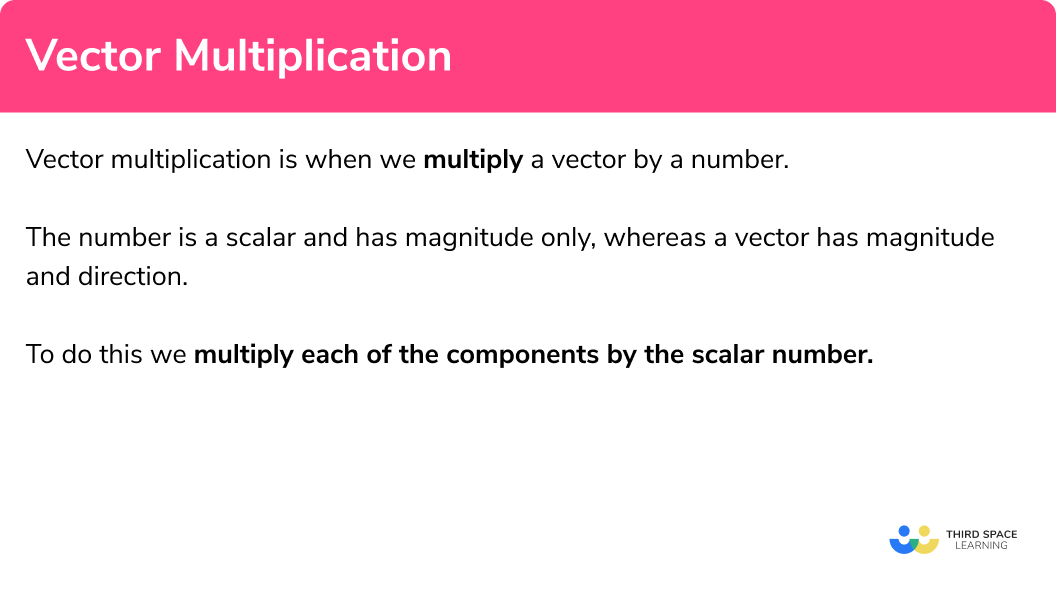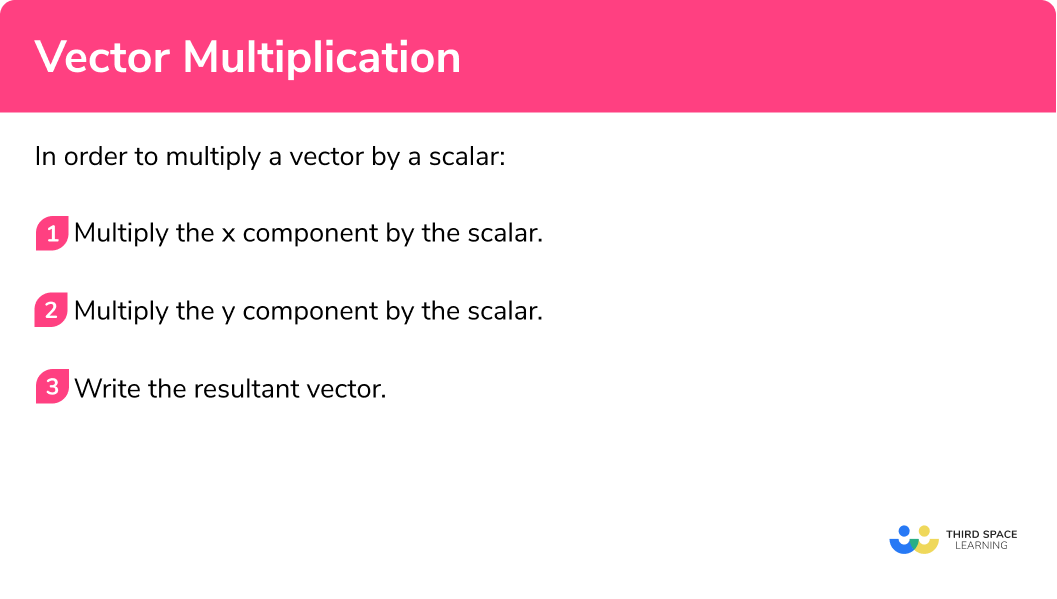GCSE Tutoring Programme
Our chosen students improved 1.19 of a grade on average - 0.45 more than those who didn't have the tutoring.
In order to access this I need to be confident with:
Addition of integers, including negative integers
Using vector notation Understanding column vectors Vector additionUsing and interpreting algebraic notation
This topic is relevant for:

Vector Multiplication
Here we will learn about vector multiplication, including scalar multiplication of a vector (multiplication of a vector by a number).
There are also vector worksheets based on Edexcel, AQA and OCR exam questions, along with further guidance on where to go next if you’re still stuck.
What is vector multiplication?
Vector multiplication is when we multiply a vector by a number. The number is a scalar and has magnitude only, whereas a vector has magnitude and direction.
To do this we multiply each of the components by the scalar number.
Here is an example:
Vector a is
So multiplying the vector a by 3 would be
This works because multiplication is repeated addition. Another way of thinking about multiplying the vector a by 3 would be
We can see this on a diagram. You can see 3 lots of the x component and 3 lots of the y component.
The direction of the vector when it is multiplied by a scalar number is the same as the original vector, but the magnitude of the vector (also called the absolute value of the vector) has changed.
What is vector multiplication?

How to multiply a vector
In order to multiply a vector by a scalar:
- Multiply the x component by the scalar.
- Multiply the y component by the scalar.
- Write the resultant vector.
How to multiply a vector


Vectors worksheet (includes vector multiplication)

Get your free vector multiplication worksheet of 20+ vectors questions and answers. Includes reasoning and applied questions.
DOWNLOAD FREE
Vectors worksheet (includes vector multiplication)

Get your free vector multiplication worksheet of 20+ vectors questions and answers. Includes reasoning and applied questions.
DOWNLOAD FREERelated lessons on vectors
Vector multiplication is part of our series of lessons to support revision on vectors. You may find it helpful to start with the main vectors lesson for a summary of what to expect, or use the step by step guides below for further detail on individual topics. Other lessons in this series include:
Vector multiplication examples
Example 1: vector multiplication
Work out:
- Multiply the x component by the scalar.
Multiply the scalar number by the top number
2\times4=82Multiply the y component by the scalar.
Multiply the scalar number by the bottom number
2\times5=103Write the resultant vector.
Write the two answers as a column vector
Example 2: vector multiplication
Work out:
Multiply the x component by the scalar.
Multiply the scalar number by the top number
4\times8=32Multiply the y component by the scalar.
Multiply the scalar number by the bottom number
4\times3=12Write the resultant vector.
Write the two answers as a column vector
Example 3: vector multiplication, decimal scalar
Work out:
Multiply the x component by the scalar.
Multiply the scalar number by the top number
0.5\times10=5Multiply the y component by the scalar.
Multiply the scalar number by the bottom number
0.5\times8=4Write the resultant vector.
Write the two answers as a column vector
Example 4: vector multiplication, fractional scalar
Work out:
Multiply the x component by the scalar.
Multiply the scalar number by the top number
\frac{1}{3}\times-6=-2Multiply the y component by the scalar.
Multiply the scalar number by the bottom number
\frac{1}{3}\times9=3Write the resultant vector.
Write the two answers as a column vector
Example 5: vector multiplication
Work out:
Multiply the x component by the scalar.
Multiply the scalar number by the top number
4\times-5=-20Multiply the y component by the scalar.
Multiply the scalar number by the bottom number
4\times-2=-8Write the resultant vector.
Write the two answers as a column vector
Example 6: vector multiplication, negative scalar
Work out:
Multiply the x component by the scalar.
Multiply the scalar number by the top number
-3\times-2=6Multiply the y component by the scalar.
Multiply the scalar number by the bottom number
-3\times5=-15Write the resultant vector.
Write the two answers as a column vector
Common misconceptions
- Make sure you multiply both components by the scalar number
Both the x component and the y component need to be multiplied by the scalar number.
- Column vectors only have 2 numbers within the brackets
Column vectors have the top number and the bottom number in the brackets. There is no need for any other punctuation marks such as commas or semicolons. There is no need for a line to separate the numbers.
Practice vector multiplication questions
1. Work out 3\textbf{a} when
\textbf{a}= \begin{pmatrix} \; 2 \;\\ \; 4 \; \end{pmatrix}




2. Work out 5\textbf{b} when
\textbf{b}= \begin{pmatrix} \; 1 \;\\ \; 3 \; \end{pmatrix}




3. Work out 0.1\textbf{c} when
\textbf{c}= \begin{pmatrix} \; 20 \;\\ \; 30 \; \end{pmatrix}




4. Work out \frac{2}{5}\textbf{a} when
\textbf{a}= \begin{pmatrix} \; -10 \;\\ \; 15 \; \end{pmatrix}




5. Work out 6\textbf{d} when
\textbf{d}= \begin{pmatrix} \; -2 \;\\ \; -3 \; \end{pmatrix}




6. Work out -3\textbf{f} when
\textbf{f}= \begin{pmatrix} \; -5 \;\\ \; -4 \; \end{pmatrix}




Vector multiplication GCSE questions
1. The vector \textbf{v} is
\textbf{v}= \begin{pmatrix} \; -3 \;\\ \; 5 \; \end{pmatrix}
Which of the vectors below is equivalent to 4\textbf{v} ?
| A | \quad \quad | B | \quad \quad | C | \quad \quad | D |
| \begin{pmatrix} \; -12 \;\\ \; 5 \; \end{pmatrix} | \quad \quad | \begin{pmatrix} \; -1 \;\\ \; 20 \; \end{pmatrix} | \quad \quad | \begin{pmatrix} \; -1 \;\\ \; 5 \; \end{pmatrix} | \quad \quad | \begin{pmatrix} \; -12 \;\\ \; 20 \; \end{pmatrix} |
(1 mark)
D
(1)
2. Vector \textbf{a} is
\textbf{a}= \begin{pmatrix} \; 3 \;\\ \; -6 \; \end{pmatrix}
Calculate 5\textbf{a}
(2 marks)
For the x component (top number)
(1)
For the y component (bottom number)
(1)
3. Here is a vector multiplication
3 \begin{pmatrix} \; -4 \;\\ \; \text{b} \; \end{pmatrix} = \begin{pmatrix} \; \text{a} \;\\ \; 24 \; \end{pmatrix}
(a) Find the value of a .
(b) Find the value of b .
(2 marks)
(a)
a=-12(1)
(b)
b=8(1)
Learning checklist
You have now learned how to:
-
Multiply a vector by a scalar
The next lessons are
Did you know?
Not covered in GCSE: we can transpose a column vector to write it as a row vector (and vice versa). These look like co-ordinates, but do not have commas.
Vectors can also be extended into A Level Maths and Further Maths by learning how to multiply two vectors together using the dot product. This is also known as the scalar product of two vectors. It is possible to multiply vectors and this is known as a cross product. This is also known as the vector product of two vectors. The cross product is linked to the right hand rule.
We can also extend vectors into three dimensions. We can also look at the vector perpendicular to a plane to give the equation of the plane.
Column vectors are a simple example of matrices. In GCSE maths we have a single column. Matrices are studied in A Level Further Maths. The number of columns and rows will be more than 1 . Matrix multiplication can be studied along with finding the inverse of a matrix. We can also find the determinant of a matrix and go further and look into eigenvalues and eigenvectors.
If a vector has a magnitude of 1 , the vector is known as a unit vector.
Still stuck?
Prepare your KS4 students for maths GCSEs success with Third Space Learning. Weekly online one to one GCSE maths revision lessons delivered by expert maths tutors.

Find out more about our GCSE maths tuition programme.